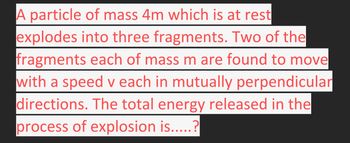Question

Transcribed Image Text:A particle of mass 4m which is at rest
explodes into three fragments. Two of the
fragments each of mass m are found to move
with a speed v each in mutually perpendicular
directions. The total energy released in the
process of explosion is.....?
Expert Solution
This question has been solved!
Explore an expertly crafted, step-by-step solution for a thorough understanding of key concepts.
Step by stepSolved in 2 steps with 1 images

Knowledge Booster
Similar questions
- 3. Consider the following two types of completely inelastic collisions between Турe A two identical masses, m. Type A: a m m particle of mass m and velocity v strikes V a stationary target consisting of an identical particle of mass m. Type B: Туре В each particle has a mass m and a speed m m v/(22) – in this case they collide head v/2/2 V/22 on. Ignore gravity, and express your answers in terms of m and v. A. What is the speed of the center of mass for type A, and for type B collisions (before the collision occurs)? What the center of mass speed after the collision for each type of collision. Justify your answers. В. ( What is the change in the total kinetic energy for type A and type B ?arrow_forwardThe carbon isotope 14C is used for carbon dating of objects. A 14C nucleus can change into a different kind of element, a neighbor on the periodic table with lower mass, by emitting a beta particle – an electron or positron – plus a neutrino or an anti-neutrino. Consider the scenario where 14C ( mass of 2.34 x 10 -26) decays by emitting an electron and anti neutrino. The electron has a mass of 9.11x 10-31 kg and a speed of 5.5 x107 m/s. While the anti neutrino has a momentum of 8.5x10-24 kg-m/s. If the electron and anti neutrino are emitted at right angles from each other, calculate the recoil speed of the nucleus.arrow_forwardAs shown in the figure below, a bullet is fired at and passes through a piece of target paper suspended by a massless string. The bullet has a mass m, a speed v before the collision with the target, and a speed (0.516)v after passing through the target. The collision is inelastic and during the collision, the amount of kinetic energy lost by the bullet and paper is equal to [(0.333)Kb BC] , that is, 0.333 of the kinetic energy of the bullet before the collision. Determine the mass M of the target and the speed V of the target the instant after the collision in terms of the mass m of the bullet and speed v of the bullet before the collision. (Express your answers to at least 3 decimals.) V =____v M = ___marrow_forward
- A radioactive nucleus at rest decays into a second nucleus, an electron, and a neutrino. The electron and neutrino are emitted at right angles and have momenta of pe = 8.95×10-23 kg-m/s and Py = 6.18x10-23 kg. m/s, respectively. (Figure 1) Figure Pnuc (nuc) +y 0 Onuc Pv Pe Part A Determine the magnitude of the momentum of the second (recoiling) nucleus. Express your answer to three significant figures and include the appropriate units. Pnuc = Submit Part B ■ μÅ Value Request Answer Pearson Units Review | Constan ?arrow_forwardThere are two relativistic particles of identical mass m that move towards each other along the same axis. The magnitudes of their momenta are the same. They collide head-on to form a new particle of mass 8m. What were the magnitudes of momenta of the initial particles?arrow_forward1. (15 pts) A moving hydrogen atom (rest mass 939 MeV/c2, wherec is the speed of light in vacuum) has a kinetic energy of 313 MeV. (a) What is the total energy of this atom in MeV? (b) What is this particle's speed in terms of c? (c) What is the magnitude of this atom's linear momentum? 24 MacBook Airarrow_forward
- Nonearrow_forwardIf 2 marbles (of same mass and speed) travel from one end of a straight line runway and strike a line of marbles, is it possible to have only one marble to pop off the other end of the line at twice the speed? Why? (explain based on momentum and kinetic energy) I tried to find the momentum for the single marble and got 2mv and found the kinetic energy to be 2mv^2 but I'm not sure if it's right or how to how to explain it if it is possible or not.arrow_forwardA saturn 5 rocket must travel 17, 800 mph to escape the gravitational pull of the earth and enter space. The rocket weight 6.2 million pounds, and the initial specific impulse lasts 263 seconds. What impulse is required for the rocket to meet the 17, 800 mph momentum in needs, using the formula FT=MV?arrow_forward
arrow_back_ios
arrow_forward_ios